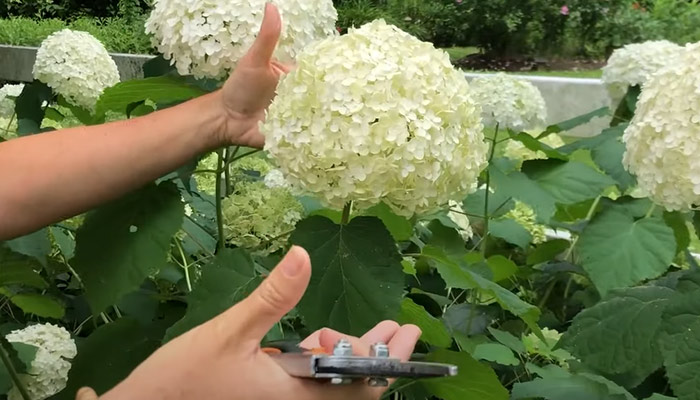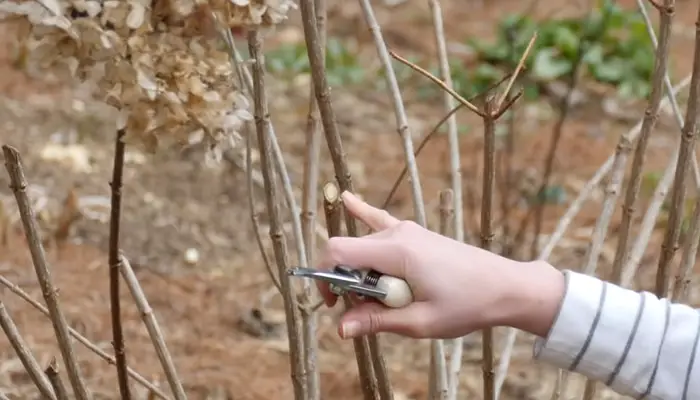Rejuvenation vs. complete renewal – the intention is of utmost importance when it comes to pruning hydrangea trees. For rejuvenation, you should simply cut off the dead flowers and take an inch or two off the newbie stems. However, for a complete renewal, you’ll need to remove the oldest stalks to the lowest level.
So, want to know how to prune tree hydrangea for better-quality and better-looking inflorescences? Well, this article’s got everything you need to know about pruning Annabelle & Limelight hydrangeas. Make sure to use the tips properly!
Should Annabelle Hydrangeas Be Cut Back?

Yes, it’s important to cut back Annabelle hydrangeas when the top gets too heavy, and the tree is unable to bear the weight. Additionally, there are a few other benefits of cutting back Annabelle hydrangeas. Let’s list down a couple of them –
Mildew Prevention
With too many branches all over the tree, Annabelle hydrangeas may become prone to mildew infestation when it gets too humid or frosty. It’s hard to detect the origin of the infestation when the mound gets too heavy and bloomy.
So, by cutting back a little bit, you can free up a little space for proper air circulation throughout the shrub. That way, it lowers the chances for the formation of residual humidity. And in turn, you can lower the possibility of mildew infestation to an extent.
Droopy Head Prevention
Annabelle hydrangeas are one of the most common hydrangea species, and you can find them almost everywhere. They’re famous for their snow-white over-the-board frosty mounted heads.
And it’s no fun if this mesmerizing view gets overshadowed by the droopiness, right?
That’s why you can’t let the top of the tree become heavier than the stem and the branches, no matter how tempting it is. With no pruning, the overgrowth of the inflorescences alone will weigh the tree down and eventually deform the rounded look of the head.
Keeping Pests At Bay
Mildew isn’t the only infestation you should stay aware of with Annabelle hydrangeas or similar hydrangea species. With too much coverage, the sunlight can’t get through to the inner leaves, branches, and flowers of these trees.
And without appropriate sunlight, these portions stay wet and humid. Consequently, they become a breeding ground for various pests like aphids and attract harmful pollinators.
Not just pests, the tree also stays at risk of developing leaf spots. With prolonged exposure to such a humid environment, the leaves and flowers alongside the branches will start to rot in these areas.
When To Cut Back Annabelle Hydrangea Trees?
You should cut back Annabelle hydrangeas when they’re not actively blooming. As in, you should avoid the flowering season altogether if you want to preserve the luscious growth. In general, it’s best to prune Annabelle hydrangea trees during the late spring or early summer season.
Annabelle hydrangeas start to grow around June or late June. Alternatively, the buds can come in a little later, around July or even August, depending on the environmental impact.
The blooming period lasts till late September, i.e., till the end of the lovely spring. After this period, you get a gorgeous shower of healthy and lovely blossoms for a couple of weeks at best.
And then, the blossoms start to fade out and die. This is when the tree mainly stays at risk of multiple fallacies. Hence, this is when you should start to cut back Annabelle hydrangea trees.
In most places, the pruning period starts in mid-October and lasts till December. The timing depends on the growth rate of the inflorescences and, in turn, their death rate as well.
Tips On Pruning Overgrown Limelight Hydrangea Plants

Other than the color of the flowers, limelight hydrangea plants have a different blooming period compared to Annabelle hydrangeas. They also need special care before and after pruning to make sure the afterward blossoms turn up just as healthy.
Here are a few tips on pruning overgrown limelight hydrangea plants to ease your tension even further –
Nourish The Soil
If you want lively blossoms alongside spacious ones, enrich the soil with organic fertilizers in time to nourish the limelight trees. Just make sure that the fertilizer comes with a balanced NPK [Nitrogen, Phosphorus & Potassium] ratio of 10-10-10.
After pruning, you should immediately focus on enriching the soil with proper nourishments for the next batch of blossoms. It’s best to fertilize the soil once in mid or late spring. Additionally, select organic fertilizers that take effect slowly because overdosing the tree with nutrients will act like poison instead.
Keep Under Direct Sunlight
Always keep limelight hydrangeas under direct sunlight or at least partial sunlight to avoid residual humidity. Especially during the pruning season, make sure the tree receives a lot of sunlight.
Doing so will help the dying flowers dry out faster and will also keep the branches and stems crisp and marginalized. Direct sunlight also helps to avoid droopiness in limelight hydrangeas.
Cut Along The Stems
While pruning, you should take off almost one-third of the entire tree to encourage further growth and radiance in the blossoms. Alongside the diseased, dead, or rotten branches, you should cut down the new branches along the stems.
New wood will emerge through these cuts, and gorgeous limelight hydrangea inflorescences will pop out from the new wood. Moreover, cutting along stems strategically will also take off the pressure from the crown itself and make the tree lighter.
When Should You Prune Overgrown Limelight Hydrangeas?
While Annabelle hydrangeas start to come in during spring, limelight hydrangeas start to fade out during the springtime. Occasionally, their blossom periods may match one another due to environmental factors, but the chances aren’t as high.
Hence, you should start to prune overgrown limelight hydrangeas during early spring, depending on the condition of the trees. Sometimes, it’s better to cut back the overgrown portions during late winter so you can have a mild blossom during the springtime.
FAQs
Q: Can you prune Annabelle hydrangeas in the spring?
It’s better to avoid pruning Annabelle hydrangeas during the springtime as the buds start to come in during this period. Instead, prune when the flowers have started to fade out during late September or early October after blooming lusciously and vividly.
Q: What are the drawbacks of pruning hydrangea trees?
The drawbacks of pruning hydrangea trees include – premature shedding, unpleasant and inconsistent growth, and lackluster inflorescences. If you don’t prune hydrangea trees properly, i.e., end up cutting through the wrong branches, you’ll risk stopping the hydrangea growth altogether.
Q: Why is it better to prune new branches over old ones?
If you choose to prune new branches over the old ones, you can prevent premature hydrangea shedding to an extent. The new branches extend out of the main ones, making them heavier. This makes the hydrangea trees vulnerable to frost and drooping.
Q: Can you naturally prevent drooping in large hydrangeas?
To prevent drooping in large hydrangeas, you should trim the branches often, so they don’t spread out too far. You can also try placing wood fences to arrange for a substantial support system.
Final Word
So, how to prune tree hydrangea in a way that doesn’t harm the overall growth of the gorgeous trees? Rejuvenate the old branches so they can grow stronger and get rid of the dead branches altogether. It’s that simple. Just make sure to prune at the right time since the blooming period varies from species to species.
- Propagating Plumeria Trees from Cuttings: Easy Steps - July 13, 2024
- How to Plant Plumeria Clippings? Easy Growth Guide - July 12, 2024
- How to Make a Plumeria Bloom? Secret Tips Revealed! - July 12, 2024

